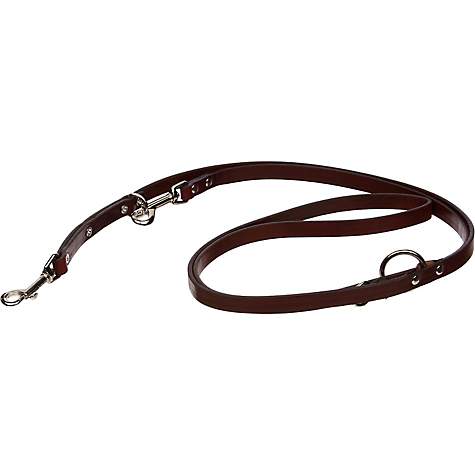Obedience Training.....Why?
I like to think of it as "manners" rather than obedience...
Obedience is what you make it. Some of the most obedient dogs I know do not have formal obedience training or AKC titles. Many formal obedience trained dogs that live their lives mainly in kennels are poor housedogs. Having an obedient Malamute is a lot of work! Consistency in your training - and being fair and firm - are important when training a Malamute. Your dog should be obedience trained to suit YOUR needs, not the needs of the trainer. What do you consider obedient? Leaping to your every whim? Listening sometimes? Obeying when it's REALLY important? There are many different intrepretations of "obedient". Perhaps you want a dog that doesn't pull on lead, get in the garbage, or steal from the countertops - then THAT is what you should train for. If you don't care if he will stay in the same spot for hours or will do a perfect heel why waste time training those things? On the other hand, perhaps you have aspirations to put an AKC obedience title on your dog. It will take practice and a good bit of frustration as Malamutes are natural comedians and enjoy embarrassing their owners in the showring! A good obedience instuctor will teach you what you want and need to know.
Often we are asked WHY take obedience classes. Usually this person has owned dogs before, maybe taken a class. They have the basics of how to teach the dog to sit, down, come, etc. Actually, the main reason you take an obedience class is to SOCIALIZE Malamutes to other dogs and impress upon them your authority so they will gain respect for you (in a kind way). It is important to introduce your Malamute to various breeds, calm dogs, hyper dogs, small dogs, yappy dogs, submissive and dominant dogs. A Malamute needs to meet other friendly dogs - big and little - so that he neither fears nor needs to dominate them and realizes that they are dogs too - not prey. In a good puppy class, he will be allowed much supervised off leash interaction with other dogs of about the same age and size. Malamutes will often not "play" as in rolling around and wrestling. Many will only go from dog to dog "checking them out" in a very detached kind of way, maybe chasing, maybe ranking. However, they gain much from this interaction. Also, you will learn how to give commands and enforce them so that your dog will respect you. You will learn several techniques to enforce your "alphaness" in a positive way so that your Malamute will not rule the house. Malamutes are dominant dogs, so it is important to gain control and respect early.
- So, what do Malamutes learn in "Puppy Kindergarten"?
- Share the doggie toys without fighting
- Being aggressive will get you chomped by somebody bigger
- Don't fight over treats, everyone gets something
- Don't bite (at least not hard)
- Dog cookies come from the nicest people
- Rest and be still after you play hard
- Most other dogs are friendly and only want to sniff your butt
- Don't let a nasty dog ruin your day, there are more friendly dogs than nasty dogs
- Some dogs have no manners, but they're ok too, just ignorant
- It's NOT ok to teach the ignorant dogs some manners though you'd like to
- I am beautiful and smart and independent, but listening to my owner will get me special praise and treats
- I am NOT at the top of the food chain
- Humans get to go through the door before dogs
- Sitting, coming and stuff like that are dumb human tricks, but they get you treats
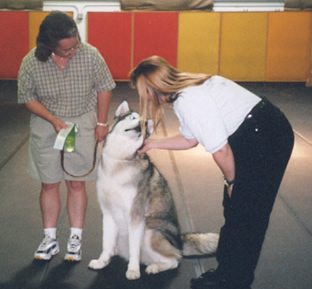
We are very proud of Diana and Koani who are working
hard at Obedience and a future Companion Dog Title.
Whereas, puppy class, with the right instructor can teach you and your dog many things - he will learn additional lessons by having an extended "pack" or special doggy friends that he lives with or sees regularly. He will learn much from mom and interaction with siblings before going home from the breeder, if he's not removed too young. These are important lessons, and Malamutes, being social pack animals need to know them. He will expect OTHER dogs to know the rules, and get very ANNOYED when other dogs do not use proper doggie manners. Some of the lessons learned in a friendly pack are:
- It's easier to catch the mouse if everyone cooperates.
- Whoever has possession is the owner of the mouse.
- Never steal someones mouse unless you can be sneaky
- Lick your paws clean after you eat. If a friend's face needs cleaning that's ok too, but wait till he's done swallowing.
- It's a waste to beg for food from another puppy, but it's OK from adults
- Live a balanced life - play some, sleep some and eat whatever you can mooch every day.
- Two puppies together can conquer the world. Four OWN it.
- Show respect to the elders, they get treats first.
- The most dominant dog gets to go through the door first.
- The top dog will always pee on the tallest bush.
- Puppies potty in the middle of the yard.
- Mark your territory outside, not in the den (house).
- Every dog deserves his own space.
- Stay out of another dog's dish.
The most important element in finding an obedience instructor is finding someone that UNDERSTANDS Malamutes. Many obedience instructors are limited in the type of dog they can train well. Whereas a golden retriever is easy to train because they are so eager to please, Mals use a different set of rules. Many instructors have very negative opinions of Mals - they feel they are pushy, aggressive, untrainable and dangerous in a class situation - stay away from these people! Sure they can be all these things in inexperienced hands around ignorant people, but they are also smart and learn quickly if properly motivated and will have the best dog manners in the class.
The most important element in finding an obedience instructor is finding someone that UNDERSTANDS Malamutes. Many obedience instructors are limited in the type of dog they can train well. Whereas a golden retriever is easy to train because they are so eager to please, Mals use a different set of rules. Many instructors have very negative opinions of Mals - they feel they are pushy, aggressive, untrainable and dangerous in a class situation - stay away from these people! Sure they can be all these things in inexperienced hands around ignorant people, but they are also smart and learn quickly if properly motivated and will have the best dog manners in the class, if not always at home!
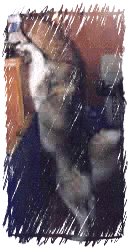 They
will not do something "stupid" in dog language out of ignorance - such as try
and take food out of another dog's mouth (unless the dog is an absolutely subserviant
quivering mass of shyness - then it deserves not to eat, or live - as seen thru
the eyes of the Malamute). Natural selection at it's best. This is a primitive
dog. Malamutes live by rules other dog breeds barely understand.
They
will not do something "stupid" in dog language out of ignorance - such as try
and take food out of another dog's mouth (unless the dog is an absolutely subserviant
quivering mass of shyness - then it deserves not to eat, or live - as seen thru
the eyes of the Malamute). Natural selection at it's best. This is a primitive
dog. Malamutes live by rules other dog breeds barely understand.
The Malamute uses advanced body language, various sounds and much expression to convey information to other dogs - but many breeds have had their primal knowledge of this "doggie language" bred out of them. A knowledgeable instructor will be able to read dogs and know when a growl is a serious threat or just a "hey, watch it!". With a Malamute you will be embarrassed because he WILL sniff a crotch, mount a less dominant dog (not for sex but for dominance), he will snap at an ill mannered mutt invading his space or mooching his food. These are important dog issues, which sometimes conflict with what people expect of dogs.
It is our job, as people and pack leaders, to teach our Malamute proper "people manners" around other dogs. Not always an easy task as these behaviors are a very strong part of the Malamute psyche. A good trainer will understand and respect your Malamute's excellent dog manners, but gently and postively reward behavior acceptable to humans as well. To forcefully correct a behavior without understanding and respecting it's basis is unfair to the dog. Many trainers have ruined good Malamutes (misusing pinch collars, "stringing them up by the neck" or other severe methods) by trying to force the Malamute to do what the Malamute believes is BAD dog behavior. He thinks, "Why do you want me to do things that can get me killed in the dog world? Are you NUTS?"
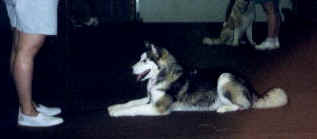
Holly in a down stay
It is VERY important you find an instructor that likes the breed. A good trainer will train with postive reinforcement most of the time. The best trainers use little or no negative reinforcement. Consider this when you choose your puppy class. You don't need a resentful, untrusting, confused and angry dog. It's hard enough to train a gentle, trusting, happy dog. A good trainer can READ dog behavior well and see problems coming, but has the tact and information to divert a problem into a good and positive lesson. A good trainer will have more than one positive way to train (because the first way doesn't always work). Most of all, a good trainer will have patience and not label your dog.
Each breed has it's strengths and weaknesses - of course some people will be more partial to retrievers or another to sighthounds - but you should NEVER get this feeling in class. A good trainer will not BORE your Malamute into acting up by talking too much or doing too many repetative drills. Actually, you want a trainer that enjoys your breed for what it is - independent, strong willed, clever and intelligent - celebrating these qualities and using them to advantage.
By now, you're thinking - this will be HARD to find! Yes, it will. But a well behaved, well socialized Malamute is an ambassador for the breed. You want people to say, gee, I want a calm well-behaved dog just like yours! (though you will laugh inside knowing all the work involved). If you can't find a class that meets your expectations - organize your own. There are other concerned pet owners out there that know how to get a dog to sit, but need socializing experiences too. If they are dog-savvy friends that have various other breeds, all the better! Visit some friendly neighborhood dogs (with the owners' permission) for a doggy playgroup! Read a good training book and together with friends and their puppies, begin your own puppy "club".
If you get really inspired there is always advanced obedience of various kinds including Agility and Rally where the dog jumps, goes over ramps and through tunnels.
This site has a nice list of trainers for most states (I don't know any of them so it's up to you to screen them, but it's good starting point). https://www.dog-training.com/trainers.htm

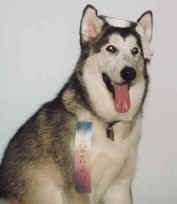 Congratulations Graduate! (Koani)
Congratulations Graduate! (Koani)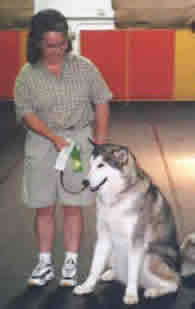
Koani receiving her 1st leg toward an obedience
title at her very first show!
Way to go Koani and Di..!
Dog Training Theories
Dogs need training, but they need appropriate training. I'm seeing a number of people that are just in awe of the Dog Whisperer show and the training methods presented there that seem to "fix" behaviors in 30 minutes. Well, it doesn't happen that way. Training is hard work - I'm sure for every dog you see fixed in 30 minutes - weeks went into modifying the behavior. There are few problems (truthfully, I can't think of any) that can be "cured" in 30 minutes with a Malamute. Even things you think you corrected will turn up over and over over time (a counter surfer will always be a counter surfer in spirit). Training is a life long, ongoing occupation with a Malamute. While I agree with Cesar's mantra of the need for calmness, exercise, consistency and taking an alpha role, there are times when he uses methods that just don't work with Malamutes. There are methods he uses that can make a borderline dog worse. I'm sure you've noticed he has never had an aggressive Malamute on his show. When Shadow was alive I used to joke we should ask him to come to Michigan - he would fail and that would be the end of his show. However, by that time Shadow was older, mellower and nothing like his younger more messed up self. It would have just created more problems...after all Shadow had come a long way - he was actually letting the UPS men pet him!
Cesar is correct in that humans tend to treat dogs as people and that gets them into trouble - a byproduct of modern society is using dogs as substitute children. Cesar has built his Dog Psychology Center around this fact. His clientele are the Hollywood rich, pampered dogs whose owners are not owners at all - but equals and oftimes intimidated by their own pets who they spoil and pamper with luxuries poor children would envy. In the olden days "a dog was a dog". They weren't allowed on furniture, they didn't get special treats, old shoes were their toys, and you didn't fence your yard for the dog, you did it for your children. That was a good life for dog in a family that were dog lovers for their time. They may have used a rolled up newspaper for discipline, but would have never let a dog sleep in the bed. They rubbed dog noses in potty accidents. If an unfenced dog got hit by a car or took off - oh well, can't be prevented. It didn't have "street smarts". I call this the "farm dawg" mentality, and it was common 50 years ago. I still see this everywhere - from people putting a dog in the back of a pickup truck to the use and misuse of fencing (by misuse I mean invisible fences or no fence at all). While we've come a long way and should never do this in these enlightened times, in some places this still exists in our society. While Malamutes are primitive dogs, it does not mean primitive methods should be used to train them. On the contrary, because of their intelligence they will know when you are using an unfair, stupid method - and you will pay for it with sassy dog that does not respect your status. There is a need for a happy medium - somewhere between allowing the Malamute to be your child and being a "farm dawg". There are many dog training methods out there. My concern is what works best with a Malamute. Consider this letter (I'll give you my opinion later):
Andrew Luescher, DVM, on Cesar Millan
Courteous Canine, Inc - Andrew Luescher, DVM, Veterinary Behaviorist, Animal
Behavior Clinic, Purdue University
By Andrew Luescher, DVM
I reviewed the four preview-videotapes kindly submitted to me by National
Geographic. I very much appreciate having gotten the opportunity to see
these tapes before the program goes on the air. I will be happy to review
any programs that deal with domestic animal behavior and training. I believe
this is a responsibility of our profession.
I have been involved in continuing education for dog trainers for over 10
years, first through the How Dogs Learn" program at the University of Guelph
(Ontario Veterinary College) and then through the DOGS! Course at Purdue
University. I therefore know very well where dog training stands today, and
I must tell you that Millan's techniques are outdated and unacceptable not
only to the veterinary community, but also to dog trainers. The first
question regarding the above mentioned tapes I have is this: The show
repeatedly cautions the viewers not to attempt these techniques at home.
What then is the purpose of this show? I think we have to be realistic:
people will try these techniques at home, much to the detriment of their
pets.
Millan's techniques are almost exclusively based on two techniques: Flooding
and positive punishment. In flooding, an animal is exposed to a fear (or
aggression) evoking stimulus and prevented from leaving the situation, until
it stops reacting. To take a human example: arachnophobia would be treated
by locking a person into a closet releasing hundreds of spiders into that
closet, and keeping the door shut until the person stops reacting. The
person might be cured by that, but also might be severely disturbed and
would have gone through an excessive amount of stress. Flooding has
therefore always been considered a risky and cruel method of treatment.
Positive punishment refers to applying an aversive stimulus or correction as
a consequence of a behavior. There are many concerns about punishment aside
from its unpleasantness. Punishment is entirely inappropriate for most types
of aggression and for any behavior that involves anxiety. Punishment can
suppress most behavior but does not resolve the underlying problem, i.e.,
the fear or anxiety. Even in cases where correctly applied punishment might
be considered appropriate, many conditions have to be met that most dog
owners can't meet: The punishment has to be applied every time the behavior
is displayed, within ½ second of the behavior, and at the correct intensity.
I would just like to point out three particularly disturbing episodes. In
one, a Great Dane is dragged onto a slippery floor by a choke chain. Again,
punishment and flooding is used. The dog was under extreme stress. The
photographer did an excellent job at documenting the excessive drooling. In
another sequence a Viszla is corrected for showing fear by inflicting pain.
Would you hit your frightened child if it was afraid, say, of heights? The
most disturbing sequence was the Entlebucher Mountain Dog with compulsive
disorder that was "treated" with a prong collar. The dog's behavior could be
compared to stereotypic rocking in a child. The method Millan used to
approach this problem would be like hitting this severely disturbed child
each time it rocks. I bet you could suppress rocking behavior, but certainly
no-one would suggest that that child was cured.
The last episode (compulsive disorder) is particularly unsettling because
compulsive disorder is related to an imbalance in neurotransmitter levels or
receptors, and is therefore unequivocally a medical condition. Would it be
appropriate to treat obsessive compulsive disorder in people with
punishment? Or have a layperson go around treating such patients?
Most of the theoretical explanations that Millan gives regarding causes of
the behavior problems are wrong. Not one of these dogs had any issue with
dominance. Not one of these dogs wanted to control their owners. What he was
right about was that calmness and consistency are extremely important, but
they don't make the presented methods appropriate or justifiable.
The title "The Dog Whisperer" is particularly ironic. The title is of course
taken from the horse whisperer. The training techniques of the horse
whisperer are based on an understanding of equine behavior, and are
non-confrontational and particularly gentle. Cesar Millan anything but
"whispers"!
I think this series, if aired, would be a major embarrassment for National
Geographic. It is not stimulating or thought-provoking, since none of the
presented techniques are new. They are outdated and have long been abandoned
by most responsible trainers, let alone behaviorists, as inappropriate and
cruel. I very much hope National Geographic will pull the plug on this
program.
My colleagues and I and innumerable leaders in the dog training community
have worked now for decades to eliminate such cruel, ineffective (in terms
of true cure) and inappropriate techniques. It would be a major blow for all
our efforts if National Geographic portrayed these very techniques as the
current standard in training and behavior modification. National Geographic
would be in a difficult situation because they would promote an individual
practicing veterinary medicine without a license (at least compulsive
disorder is a medical condition, and the diagnosis of any behavior problem
is considered practicing veterinary medicine in the model veterinary
practice act). I also would not be surprised if the large national animal
welfare organizations were to sue National Geographic for promoting cruelty
to animals. I can guarantee to you that they would have the support of all
professional organizations involved in dog behavior and training.
Andrew Luescher, DVM, Veterinary Behaviorist, Animal Behavior Clinic, Purdue
University
via courteouscanine.com
We are in agreement that Cesar uses some pretty antiquated methods, and sometimes quite inappropriately. But what DO you use with a Malamute? Positive reinforcement only goes so far with some dogs, and when you have a Malamute one day you will discover this. So perhaps a real world example will be helpful.
This morning we handed out new toys and a fight erupted after playing nicely among themselves for over a half hour. It was like the flashpoint in a fire - it erupted spontaneously. Had I not been playing with my camera, I'd have seen the precipitating posture, but I didn't. It was a minor fight with 5 dogs - Mula corrected Mocha, then Jazzy went for Mula because that's HER puppy (she's 1 1/2 but still mommy's puppy), after which Simone joined in and Jazzy corrected HER, then Riggs got involved to keep pack order....(only Theodore stayed out of the fray). What do you do? No, you don't beat the instigators...(though you'd like to - and good luck figuring out who is the instigator? Mocha who overstepped her bounds or Mula that corrected her?). The worst thing to do is yell and freak out. First you CALMLY separate and diffuse the fight. Keep them apart, Jazz still had her hackles up so she got some crate time (aka timeout)...Mula did too on principle since Mocha had a couple of deep scratches on her nose from Mula's correction. Mocha and the puppies got a strong scolding since they really didn't do anything wrong (it was an over-reaction by the "mommy's"). Riggs was doing his job as alpha male trying to keep pack order. It wasn't a "serious" fight so we didn't have to be ogres this time. Everyone stopped when we told them to - no one "kept coming back for more", so the punishment has to fit the crime. This wasn't a "I want to kill you and die" fight. So the punishment was somewhat low-key. Did we beat them with a newspaper, no. Yell, no (that would have escalated things). We just growled "cut it out" and separated them and went about our business. So is life with Malamutes!
Generally you try positive reinforcement first, which takes time and has the best long term results. If something that positive reinforcement can't be used for happens - say a fight - use the least severe method to get results. In this case it was a time out and some crate time - separation from the pack. Had it been a severe "kill them!" type of fight, it would have meant pinning and perhaps a bite on the nose (from us) to the instigator (yes, antiquated training methods) to make a point. How do I know what kind of fight it was? It would have taken much more than firmly growling at them to end it. So, in general, while the above dog behaviorist is generally right, Cesar is also right when their is no "psychological problem" going on. The answer lies somewhere in between. The cardinal rule is do not make the problem worse. Do not punish more severely than the crime merits. Use positive reinforcement whenever possible. If you're not sure, or it's something weird, have a professional evaluate the situation but always keep in mind you know your dog best. Even behaviorists can be wrong. There is no right/wrong answer sometimes - you have to do what works. Every trainer has their favorite "methods" and there are some general rules to follow:
- Never call a dog to punish him (or he won't come next time). Doing that undermines his trust in you.
- The punishment should fit the crime (no matter how angry you are he ate your wallet). Save your severe punishments for things that endanger life and limb.
- Make rules and enforce them. Consistency!!! All family members should be in agreement as to what the rules are.
- Don't be overly affectionate with your dog if you aren't willing to be a leader too. (Recipe for disaster with a pushy dominant Malamute and even a shy/non-pushy Malamute may take advantage of this perceived "status" indicator).
- Give enough exercise and something to do, bored busy dogs get into trouble.
- Try positive reinforcement first. If the dog is say, jumping up - show him what to do and praise - every time he jumps. It works better and the results are longer lasting when he finally "gets it" though it may take longer to achieve a result.
- Be firm and don't waver in your discipline...be confident in your approach - he will sense your waffling and take advantage of it.
- If the dog seems to have a serious problem (separation anxiety, obsessive/compulsive behaviors) you should consult a professional behaviorist so you don't make the problem worse.
- A problem can appear to be "dominance" related and not be. Some very manipulative dogs are not dominant at all.
- Flooding and excessive punishment never work with Malamutes - you will likely make a shy dog shyer, or an aggressive dog vicious.
- Always use a non-confrontational method for an aggressive situation.
- When unsure, find a way to use positive reinforcement - you'll do no harm and won't make problems worse
- It's ok to use certain caveman techniques with certain Malamutes - but use them sparingly and only for serious infractions (fighting, biting). Scruff shakes, pinning and chucks under the chin have a place. However, used with a sensitive, shy or timid dog this can CAUSE aggression. I am hesitant to say this only because some people tend to go overboard with these "old fashioned" methods, but they do have their place with pushier, confident, more primitive Malamutes. This is not a dog you can say "no no poochie-poo, that was a baaaaaad doggie and mommy is angry"...they'll laugh at you.
- You will find the things you have the most success with are the things you are doing best. (and why shouldn't that be?) If it's not working, try something else.
- Sometimes the best solution is the practical one. If you have dogs, don't buy white carpet and expect them to keep it clean. Not gonna happen! Common sense goes a long way.
More Pups in Obedience!
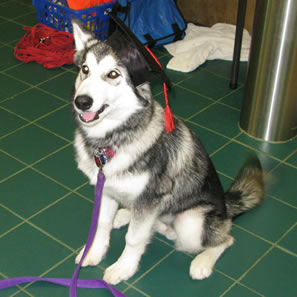 Kiska
Kiska 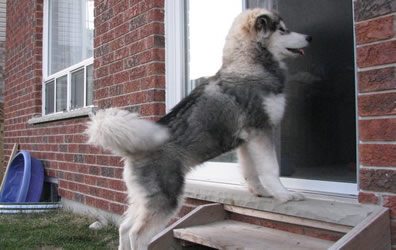 Kava
Kava
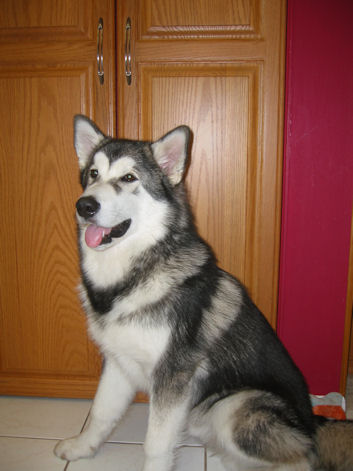 Shadow
Shadow
More information & Helpful links...
Recommended Obedience Schools in SE Michigan
(if there is someone you think highly of that really understands Malamutes, let me know and I'll add them)
Sportsmen's Dog Training
- Warren, MI
Ann Arbor Dog Training Club
- Ann Arbor, MI
Northfield Dog Training
- Ann Arbor, MI
BOOKS ON DOG OBEDIENCE









